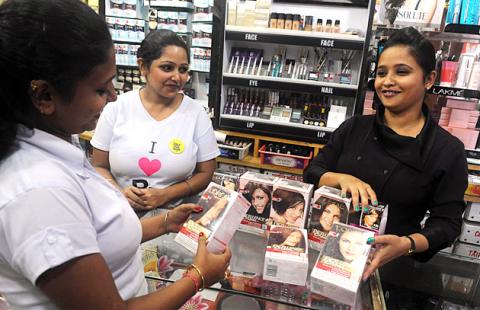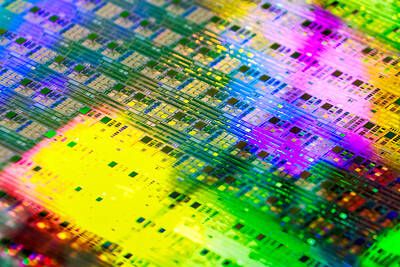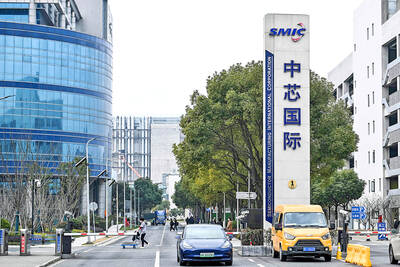Global cosmetic firms are turning to emerging markets in the hunt for sales, but they face a challenge tailoring their beauty products to suit new customers in India, China and elsewhere.
The London-based Euromonitor research group forecasts global growth worth US$64 billion within five years, including US$26 billion in the Asia-Pacific region and US$22 billion in Latin America.
“If you want to get a piece of the action, then you have to be present,” Euromonitor analyst Oru Mohiuddin told reporters. “We see that growth in emerging markets is enormous.”

Photo: AFP
L’Oreal, one of the world’s largest cosmetics makers, has set up research centers and factories in countries such as India, Mexico and Indonesia, and is adapting marketing and sales strategies to adapt to local consumer habits.
The French company estimates that by 2025 annual spending per head on beauty products will have grown in India from US$4 to US$13.
“Most groups continue to strengthen their regional and local structures [in emerging markets],” said Laurent Dusollier, an analyst in Paris for Roland Berger consultants. “Having established research and development centers, they have created specific products and marketing approaches, and strengthened their management teams.”
One of the key tests for firms trying to tap into new consumer tastes among India’s 1.2 billion population is to understand that most people shop in small neighborhood outlets rather than at supermarkets.
“There is a challenge of distribution and product availability, especially as there is no modern-style trading,” Dusollier said.
L’Oreal has experimented with selling products in cheap, individual sachets for a few rupees, and says 750,000 small shops now offer its goods nationwide.
The company has also used Garnier, which it owns, to develop a special range of products that use Indian ingredients and is testing makeup products to expand beyond hair and skincare sales.
“Our ambition is to become the No. 1 beauty company in [the] Asia-Pacific [region] and the No. 1 among emerging upper and middle class consumers,” L’Oreal’s regional managing director Jochen Zaumseil said.
“We expect strong growth in the next decade,” he said, adding the company wanted to make products “more accessible” and that it was considering mergers and acquisitions.
India’s economic growth has slowed sharply from nearly 10 percent four years ago to 5.5 percent in the latest quarterly figures — but Zaumseil says that L’Oreal grew by 25 percent last year in the country.
The company sees the high-end section of the market as the most attractive target, as it believes at least 60 percent of wealthy Indians currently buy luxury goods while traveling abroad.
The rapid emergence of sleek new shopping malls in cities like New Delhi, Mumbai and Bangalore points to a solid future for L’Oreal’s elite brands, including Lancome, Yves Saint Laurent and Kiehls.
“This is a long-term game and a very new market,” said Dinesh Dayal, chief operating officer for L’Oreal India.

SEMICONDUCTOR SERVICES: A company executive said that Taiwanese firms must think about how to participate in global supply chains and lift their competitiveness Taiwan Semiconductor Manufacturing Co (TSMC, 台積電) yesterday said it expects to launch its first multifunctional service center in Pingtung County in the middle of 2027, in a bid to foster a resilient high-tech facility construction ecosystem. TSMC broached the idea of creating a center two or three years ago when it started building new manufacturing capacity in the US and Japan, the company said. The center, dubbed an “ecosystem park,” would assist local manufacturing facility construction partners to upgrade their capabilities and secure more deals from other global chipmakers such as Intel Corp, Micron Technology Inc and Infineon Technologies AG, TSMC said. It

People walk past advertising for a Syensqo chip at the Semicon Taiwan exhibition in Taipei yesterday.

NO BREAKTHROUGH? More substantial ‘deliverables,’ such as tariff reductions, would likely be saved for a meeting between Trump and Xi later this year, a trade expert said China launched two probes targeting the US semiconductor sector on Saturday ahead of talks between the two nations in Spain this week on trade, national security and the ownership of social media platform TikTok. China’s Ministry of Commerce announced an anti-dumping investigation into certain analog integrated circuits (ICs) imported from the US. The investigation is to target some commodity interface ICs and gate driver ICs, which are commonly made by US companies such as Texas Instruments Inc and ON Semiconductor Corp. The ministry also announced an anti-discrimination probe into US measures against China’s chip sector. US measures such as export curbs and tariffs

The US on Friday penalized two Chinese firms that acquired US chipmaking equipment for China’s top chipmaker, Semiconductor Manufacturing International Corp (SMIC, 中芯國際), including them among 32 entities that were added to the US Department of Commerce’s restricted trade list, a US government posting showed. Twenty-three of the 32 are in China. GMC Semiconductor Technology (Wuxi) Co (吉姆西半導體科技) and Jicun Semiconductor Technology (Shanghai) Co (吉存半導體科技) were placed on the list, formally known as the Entity List, for acquiring equipment for SMIC Northern Integrated Circuit Manufacturing (Beijing) Corp (中芯北方積體電路) and Semiconductor Manufacturing International (Beijing) Corp (中芯北京), the US Federal Register posting said. The